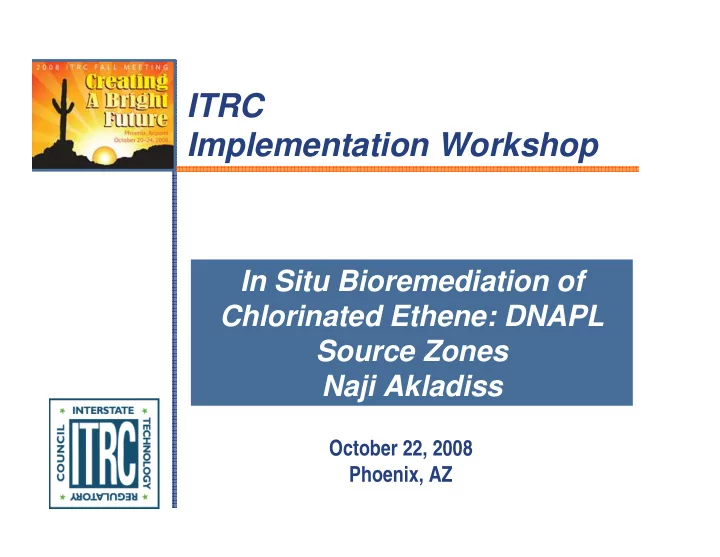

ITRC Implementation Workshop In Situ Bioremediation of Chlorinated Ethene: DNAPL Source Zones Naji Akladiss October 22, 2008 Phoenix, AZ
Overview • Tens of thousands of DNAPL source zones exist in federal and private sites • Current technologies used to remediate DNAPL require introduction of energy (e.g. Steam or heat), fluids ((Surfactants) or chemical (KMnO 4 ) primarily to mobilize DNAPL so that it can be recovered. • ISB of DNAPL uses micro-organisms – which can proliferate and degrade DNAPL without mobilization and provide a far more efficient, effective and less costly remediation alternative. • Regulators and practitioners need to understand the proper application and limitations of BioDNAPL • Monitoring the removal of mass in a DNAPL Source Zones uses groundwater chemical parameters – not contaminant concentrations in groundwater. • May not see immediate results. Improvement may occur within months of the application of the technology.
Tech-Reg Content • In Situ Bioremediation of DNAPL is; – Removal of DNAPL source mass by dissolution at the DNAPL/water interface and destruction of dissolved chlorinated organics using in situ bioremediation • The Tech-Reg – Contains a decision tree beginning on Page 20 (Figure 2-5) that describes the major decision within the design and operational monitoring steps for ISB of DNAPL Source Zones – Describes the advantages and limitations of using ISB of DNAPL source zones. – Describes the monitoring requirement for the process, the performance and compliance – Describes the parameters practitioners and regulators should consider when optimizing the performance. – Describes how ISB of DNAPL source zones can accelerate the cleanup of the site – Refers to case studies where ISB of DNAPL has been applied
Steps to Achieve Impact • The regulatory programs should concur with the guidance and notify the practitioners that they are receptive to properly designed remediation plans incorporating ISB of DNAPL • Practitioners should use the Tech-Reg as a guide when preparing remediation work plans and reference the Tech-Reg as the basis of their work plan. • Practitioners following the Tech-Reg can demonstrate that destruction of DNAPL using ISB at the source zones can accelerate the overall site cleanup and thereby reduce chronic exposure and Regulators must acknowledge that DNAPL mass reduction will shorten the overall remediation time. • RPs can reduce there lifecycle liability by using destructive technologies like ISB of DNAPL source zone
Where Tech-Reg Will Provide Impact EXPECTED INTENDED USE OF TECH-REG BENEFIT TO BE RECEIVED BY USERS USER Site owners As a guide to evaluate the merits of Shorter remediation time frame / reduce ISB of DNAPL at a source zone and lifecycle cost / reduce the long term potential assess reducing their long term risk environmental liability Regulators Use the performance metrics Effective reduction of mass and long term described in the document to risk understand the benefit of ISB at their site Practitioners Develop remediation plans Lower up-front costs traded off for long term including ISB of DNAPL source monitoring zones that state regulators will accept and be familiar with. Community The application is applied and Feel comfortable that ISB of DNAPL is designed according to a guidance applied properly and the outcome does not developed by states along with increase the toxicity of the contaminants or practitioners long term risk.
We Use the Tech-Reg Baseline geochemistry and hydrogeology sampling Maine has received a proposal Remedy selection and initial design to incorporate ISB of DNAPL Revise design into a site remediation. Design support and pilot study sampling Are The consulting firm referenced No key design assumptions validated? the Tech-Reg in the proposal. Yes As a result, the State will refer Final design and full-scale system construction Modify the operation to the Tech-Reg while Full-scale system operation Troubleshooting based on reviewing the proposal. expanded variables list, Key system operating parameters — which may include TOC, pH, VOCs, ethene, methane expanded geochemistry, microbial population characterization, functional Continue operation Are enzyme analysis, and No system variables other analytes. See Table within accepted 5.1 for further explanation. range? No Yes Are project objectives achieved? Yes Remedy complete
Specific Implementation Target Ideas • Nearly all military installations and DOE facilities encounter DNAPL contamination. Feasibility studies should consider the use of ISB of DNAPL source zones thereby reducing costs, long term environmental liability, and risk • Large manufacturing facilities can have extensive DNAPL contamination and should consider this destructive technology. • Universities with environmental curriculums should include the guidance as a resource describing the application of ISB of DNAPL source zones • The dry cleaning industry should universally consider ISB of DNAPL especially at suburban sites.
Recommend
More recommend